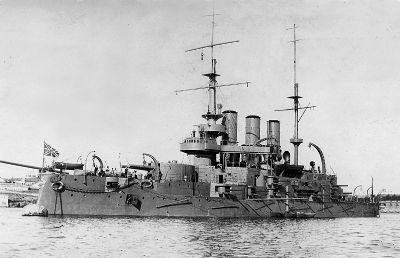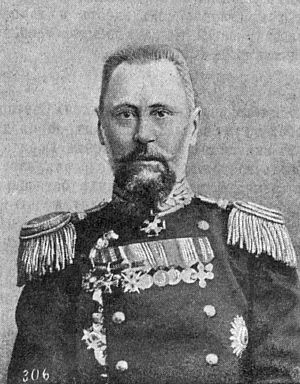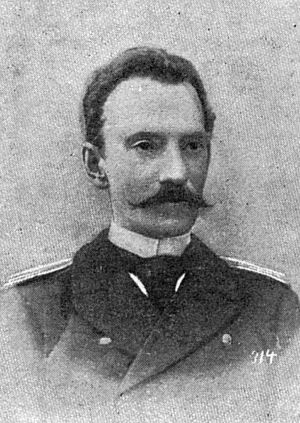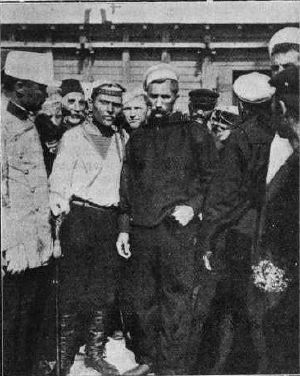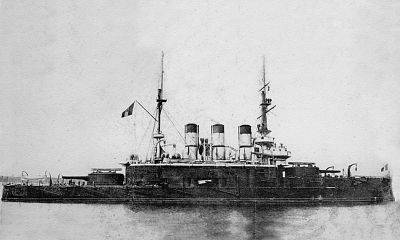Russian battleship Potemkin
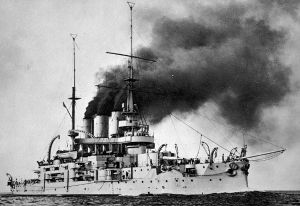 Panteleimon at sea, 1906 | |
| History Russian Empire | Russian Empire |
|---|---|
| Named after: | • Grigory Potemkin
• Saint Pantaleon |
| Builder: | Nikolaev Admiralty Shipyard |
| Laid down: | 10 October 1898[1] |
| Launched: | 9 October 1900 |
| Decommissioned: | March 1918 |
| In service: | Early 1905 |
| Out of service: | 19 April 1919 |
| Struck: | 21 November 1925 |
| Status: | Scrapped, 1923 |
| General characteristics | |
| Displacement: | • 12,480 LT (12,680 t) (designed)
• 12,900 LT (13,107 t) (actual) |
| Length: | 378 feet 6 inches (115.4 m) |
| Beam: | 73 ft (22.3 m) |
| Draught: | 27 ft (8.2 m) |
| Propulsion: | 2 shafts, 2 Vertical triple-expansion steam engines |
| Speed: | 16 knots (30 km/h; 18 mph) |
| Range: | 3,200 nautical miles (5,900 km; 3,700 mi) at 10 knots (19 km/h; 12 mph) |
| Complement: | 26 officers, 705 enlisted men |
| Armament: | • 2 × twin 12 in (305 mm) guns
• 16 × single 6 in (152 mm) guns |
| Armour: | • Krupp cemented armour • Waterline belt: 9 in (229 mm) |
The Russian battleship Potemkin (Russian: Князь Потёмкин Таврический, "Prince Potemkin of Taurida") was a pre-dreadnought battleship built for the Imperial Russian Navy's Black Sea Fleet. She became famous when the crew rebelled against the officers in June 1905 (during that year's revolution), which is now viewed as a first step towards the Russian Revolution of 1917. The mutiny later formed the basis of Sergei Eisenstein's 1925 silent film The Battleship Potemkin.
After the mutineers sought asylum in Constanța, Romania, and after the Russians recovered the ship, her name was changed to Panteleimon. She accidentally sank a Russian submarine in 1909 and was badly damaged when she ran aground in 1911. During World War I, Panteleimon participated in the Battle of Cape Sarych in late 1914. She covered several bombardments of the Bosphorus fortifications in early 1915, including one during which the ship was attacked by the Turkish battlecruiser Yavuz Sultan Selim – Panteleimon and the other Russian pre-dreadnoughts present drove her off before she could inflict any serious damage. The ship was relegated to secondary roles after Russia's first dreadnought battleship entered service in late 1915. She was by then obsolete and was reduced to reserve in 1918 in Sevastopol.
Panteleimon was captured when the Germans took Sevastopol in May 1918 and was handed over to the Allies after the Armistice in November 1918. Her engines were destroyed by the British in 1919 when they withdrew from Sevastopol to prevent the advancing Bolsheviks from using them against the White Russians. She was abandoned when the Whites evacuated the Crimea in 1920 and was finally scrapped by the Soviets in 1923.
Design and construction
Planning
Planning began in 1895 for a new battleship that would utilize a slipway slated to become available at the Nikolayev Admiralty Shipyard in 1896. The Naval Staff and the commander of the Black Sea Fleet, Vice Admiral K. P. Pilkin, agreed on a copy of the Peresvet-class battleship design, but they were overruled by General Admiral Grand Duke Alexei Alexandrovich. The General Admiral decided that the long range and less powerful 10-inch (254 mm) guns of the Peresvet class were inappropriate for the narrow confines of the Black Sea, ordering the design of an improved version of the battleship Tri Sviatitelia instead. The improvements included a higher forecastle to improve the ship's seakeeping qualities, Krupp cemented armor and Belleville boilers. The design process was complicated by numerous changes demanded by various departments of the Naval Technical Committee. The ship's design was finally approved on 12 June 1897, although design changes continued to be made that slowed the ship's construction.[2]
Construction and sea trials
Construction of Potemkin began on December 27, 1897 and she was laid down at the Nikolayev Admiralty Shipyard on October 10, 1898. She was named in honor of Prince Grigory Potemkin, a Russian soldier and statesman best known as a favorite of Catherine the Great who purported created fake Potemkin villages for her trip to Crimea.[3] The ship was launched on October 9, 1900 and transferred to Sevastopol for fitting out on July 4, 1902. She began sea trials in September 1903 and these continued, off and on, until early 1905 when her gun turrets were completed.[4]
Description
Potemkin was 371 feet 5 inches (113.2 m) long at the waterline and 378 feet 6 inches (115.4 m) long overall. She had a beam of 73 feet (22.3 m) and a maximum draught of 27 feet (8.2 m). She displaced 12,900 long tons (13,100 t), 420 long tons (430 t) more than its designed displacement of 12,480 long tons (12,680 t). Potemkin's crew consisted of 26 officers and 705 enlisted men.[5]
The ship had a pair of three-cylinder vertical triple-expansion steam engines, each of which drove one propeller, that had a total designed output of 10,600 indicated horsepower (7,900 kW). Twenty-two Belleville boilers provided steam to the engines at a pressure of 15 atm (1,520 kPa; 220 psi). The 8 boilers in the forward boiler room were oil-fired and the remaining 14 were coal-fired. During her sea trials on 31 October 1903, she reached a top speed of 16.5 knots (30.6 km/h; 19.0 mph). Leaking oil caused a serious fire on 2 January 1904 that caused the navy to convert her boilers to coal firing at a cost of 20,000 rubles. The ship carried a maximum of 1,100 long tons (1,100 MT) of coal at full load that provided a range of 3,200 nautical miles (5,900 km; 3,700 mi) at a speed of 10 knots (19 km/h/12 mph).[6]
Armament
The main armament consisted of four 40-caliber 12-inch (305 mm) guns mounted in twin gun turrets fore and aft of the superstructure. The electrically operated turrets were derived from the design of those used by the Petropavlovsk-class battleships. These guns had a maximum elevation of +15° and their rate of fire was very slow, only one round every four minutes during gunnery trials.[7] They fired a 337.7-kilogram (745 lb) shell at a muzzle velocity of 2,792 ft/s (851 m/s). At an elevation of +10° the guns had a range of 12,000 meters (13,000 yd).[8] Potemkin carried 60 rounds for each gun.[9]
The sixteen 45-calibre, 6-inch (152 mm) Canet Pattern 1891 quick-firing (QF) guns were mounted in casemates. Twelve of these were placed on the sides of the hull and the other four were positioned at the corners of the superstructure.[9] They fired shells that weighed 41.46 kg (91.4 lb) with a muzzle velocity of 792 m/s (2,600 ft/s). They had a maximum range of 11,523 meters (12,602 yd) when fired at an elevation of +20°.[10] The ship stowed 160 rounds per gun.[11]
Smaller guns were carried for close-range defense against torpedo boats. These included fourteen 50-caliber Canet QF 75-millimeter (3.0 in) guns: four in hull embrasures and the remaining 10 mounted on the superstructure. The ship carried 300 shells for each gun.[9] They fired an 4.9-kilogram (11 lb) shell at a muzzle velocity of 2,700 ft/s (820 m/s) to a maximum range of 6,405 meters (7,005 yd).[12] She also mounted six 47-millimeter (1.9 in) Hotchkiss guns. Four of these were mounted in the fighting top and two on the superstructure.[9] They fired a 2.2-pound (1.00 kg) shell at a muzzle velocity of 1,400 ft/s (430 m/s).[13]
Potemkin had five underwater 15-inch (381 mm) torpedo tubes: one in the bow and two on each broadside. She carried three torpedoes for each tube.[9] The model of torpedo in use changed over time; the first torpedo that the ship would have been equipped with was the M1904. It had a warhead weight of 70 kilograms (150 lb) and a speed of 33 knots (61 km/h/38 mph) with a maximum range of 800 meters (870 yd).[14]
In 1907 telescopic sights were fitted for the 12-inch and 6-inch guns. In that or the following year 2.5-meter (8 ft 2 in) rangefinders were installed. The bow torpedo tube was removed in 1910–11, as was the fighting top. The following year the main-gun turret machinery was upgraded and the guns were modified to improve their rate of fire to one round every 40 seconds.[15]
Two 57-millimeter (2.2 in) anti-aircraft (AA) guns were mounted on the ship's superstructure on 3–6 June 1915; they were supplemented by two 75 mm AA guns, one on top of each turret, probably during 1916. In February 1916 the ship's four remaining torpedo tubes were removed. At some point during World War I, her 75 mm guns were also removed.[16]
Protection
The maximum thickness of the Krupp cemented armor waterline belt was 9 inches (229 mm) which reduced to 8 inches (203 mm) abreast the magazines. It covered 237 feet (72.2 m) of the ship's length and 2-inch (51 mm) plates protected the waterline to the ends of the ship. The belt was 7 feet 6 inches (2.3 m) high, of which 5 feet (2 m) was below the waterline, and tapered down to a thickness of 5 inches (127 mm) at its bottom edge. The main part of the belt terminated in 7-inch (178 mm) transverse bulkheads.[9]
Above the belt was the upper strake of six-inch armor that was 156 feet (47.5 m) long and closed off by six-inch transverse bulkheads fore and aft. The upper casemate protected the six-inch guns and was five inches thick on all sides. The sides of the turrets were 10 inches (254 mm) thick and they had a two-inch roof. The conning tower's sides were nine inches thick. The nickel-steel armor deck was two inches thick on the flat amidships, but 2.5 inches (64 mm) thick on the slope connecting it to the armor belt. Fore and aft of the armored citadel, the deck was 3 inches (76 mm) to the bow and stern.[9] In 1910–11, additional 1-inch (25 mm) armor plates were added fore and aft; their exact location is unknown, but they were probably used to extend the height of the two-inch armor strake at the ends of the ship.[17]
Service
Mutiny
During the Russo-Japanese War of 1904–1905, many of the Black Sea Fleet's most experienced officers and enlisted men were transferred to the ships in the Pacific to replace losses. This left the fleet with primarily raw recruits and less capable officers. With the news of the disastrous Battle of Tsushima in May 1905 morale dropped to an all-time low, and any minor incident might have been enough to spark a major catastrophe. Taking advantage of the situation, plus the disruption caused by the ongoing riots and uprisings, the Central Committee of the Social Democratic Organization of the Black Sea Fleet, called Tsentralka (short for Central Committee), had started preparations for a simultaneous mutiny on all of the ships of the fleet, although the timing had not been decided.[18]
On June 27, 1905, Potemkin was at gunnery practice near Tendra Spit off the Ukrainian coast when many enlisted men refused to eat the borscht made from rotten meat partially infested with maggots. The uprising was triggered when Ippolit Giliarovsky, the ship's second in command, allegedly threatened to shoot crew members for their refusal. He summoned the ship's marine guards as well as a tarpaulin to protect the ship's deck from any blood in an attempt to intimidate the crew. Giliarovsky was killed after he mortally wounded Grigory Vakulinchuk, one of the mutiny's leaders. The mutineers killed seven of the Potemkin's eighteen officers, including Captain Evgeny Golikov (ru), and captured the torpedo boat Ismail (No. 627). They organized a ship's committee of 25 sailors, led by Afanasi Matushenko, to run the battleship.[19]
The committee decided to head for Odessa flying a red flag and arrived there later that day at 22:00. A general strike had been called in the city and there was some rioting as the police tried to quell the strikers. The following day the mutineers refused to supply a landing party to help the striking revolutionaries take over the city, preferring instead to await the arrival of the other battleships of the Black Sea Fleet. Later that day the mutineers aboard the Potemkin captured a military transport, Vekha, that had arrived in the city. The riots continued as much of the port area was destroyed by fire. On the afternoon of 29 June, Vakulinchuk's funeral turned into a political demonstration and the army attempted to ambush the sailors who participated in the funeral. In retaliation, the ship fired two six-inch shells at the theater where a high-level military meeting was scheduled to take place, but missed their target.[20]
Vice Admiral Grigoriy Chukhnin, commander of the Black Sea Fleet, issued an order to send two squadrons to Odessa either to force the Potemkin's crew to give up or sink the battleship. Potemkin sortied on the morning of June 30th to meet the three battleships Tri Sviatitelia(Three Saints), Dvenadsat Apostolov (Twelve Apostles), and Georgii Pobedonosets of the first squadron, but the loyal ships turned away. The second squadron arrived with the battleships Rostislav and Sinop later that morning, and Vice Admiral Aleksander Krieger, acting commander of the Black Sea Fleet, ordered the ships to proceed to Odessa. Potemkin sortied again and sailed through the combined squadrons as Krieger failed to order his ships to fire. Captain Kolands of Dvenadsat Apostolov attempted to ram Potemkin and then detonate his ship's magazines, but he was thwarted by members of his crew. Krieger ordered his ships to fall back, but the crew of Georgii Pobedonosets mutinied and joined Potemkin.[21]
The following morning, loyalist members of Georgii Pobedonosets retook control of the ship and ran her aground in Odessa harbor.[22] The crew of Potemkin, together with Ismail, decided to sail for Constanța later that day where they could restock food, water and coal. The Romanians refused to provide the supplies, backed by the presence of their small protected cruiser Elisabeta, so the ship's committee decided to sail for the small, barely defended port of Theodosia in the Crimea where they hoped to resupply. The ship arrived on the morning of July 5th, but the city's governor refused to give them anything other than food. The mutineers attempted to seize several barges of coal the following morning, but the port's garrison ambushed them and killed or captured 22 of the 30 sailors involved. They decided to return to Constanța that afternoon.[23]
Potemkin reached its destination at 23:00 on July 7th and the Romanians agreed to give asylum to the crew if they would disarm themselves and surrender the battleship. Ismail's crew decided the following morning to return to Sevastopol and turn themselves in, but Potemkin's crew voted to accept the terms. Captain Negru, commander of the port, came aboard at noon and hoisted the Romanian flag and then allowed the ship to enter the inner harbor. Before the crew disembarked, Matushenko ordered that the Potemkin's Kingston valves be opened so she would sink to the bottom.[24]
Later service
When Rear Admiral Pisarevsky reached Constanța on the morning of July 9th, he found the Potemkin half sunk in the harbor and flying the Romanian flag. After several hours of negotiations with the Romanian Government, the battleship was handed over to the Russians. Later that day the Russian Navy Ensign was raised over the battleship.[25] She was then easily re-floated by the navy, but the salt water had damaged her engines and boilers. The ship left Constanța on July 10th, having to be towed back to Sevastopol, where she arrived on July 14th.[26] The ship was renamed Panteleimon (Russian: Пантелеймон), after Saint Pantaleon,[27] on October 12, 1905. Some members of Panteleimon's crew joined a mutiny that began aboard the protected cruiser Ochakov (ru) in November, but it was easily suppressed as both ships had been earlier disarmed.[26]
Panteleimon received an experimental underwater communications set[28] in February 1909. Later that year, she accidentally rammed and sank the submarine Kambala (ru) on the night of June 11th [according to Russian sources, Kambala sank in a collision with the battleship Rostislav, not with Panteleimon],[26] killing the 16 crewmen aboard the submarine.[29]
While returning from a port visit to Constanța in 1911, Panteleimon ran aground on October 2nd. It took several days to re-float her and make temporary repairs, and the full extent of the damage to its bottom was not fully realized for several more months. The ship participated in training and gunnery exercises for the rest of the year; a special watch was kept to ensure that no damaged seams were opened while firing. Permanent repairs, which involved replacing its boiler foundations, plating, and a large number of its hull frames, lasted from January 10 to April 25, 1912. The navy took advantage of these repairs to overhaul its engines and boilers.[30]
World War I
Panteleimon, flagship of the 1st Battleship Brigade, accompanied by the pre-dreadnoughts Evstafi, Ioann Zlatoust, and Tri Sviatitelia, covered the pre-dreadnought Rostislav while it bombarded Trebizond on the morning of November 17, 1914. They were intercepted the following day by the Ottoman battlecruiser Yavuz Sultan Selim (the ex-German SMS Goeben) and the light cruiser Midilli (the ex-German SMS Breslau) on their return voyage to Sevastopol in what came to be known as the Battle of Cape Sarych. Despite the noon hour the conditions were foggy; the capital ships initially did not spot each other. Although several other ships opened fire, hitting the Goeben once, Panteleimon held fire because its turrets could not see the German ships before they disengaged.[31]
Tri Sviatitelia and Rostislav bombarded Ottoman fortifications at the mouth of the Bosphorus on March 18, 1915, the first of several attacks intended to divert troops and attention from the ongoing Gallipoli Campaign, but fired only 105 rounds before sailing north to rejoin Panteleimon, Ioann Zlatoust and Evstafi.[32] Tri Sviatitelia and Rostislav were intended to repeat the bombardment the following day, but were hindered by heavy fog.[33] On 3 April, Yavuz Sultan Selim and several ships of the Turkish navy raided the Russian port at Odessa; the Russian battleship squadron sortied to intercept them. The battleships chased Yavuz Sultan Selim the entire day, but were unable to reach effective gunnery range and were forced to break off the chase.[34] On April 25 Tri Sviatitelia and Rostislav repeated their bombardment of the Bosphorus forts. Tri Sviatitelia, Rostislav and Panteleimon bombarded the forts again on May 2 and 3. This time a total of 337 main-gun rounds were fired in addition to 528 six-inch shells between the three battleships.[35]
On May 9, 1915, Tri Sviatitelia and Panteleimon returned to bombard the Bosphorus forts, covered by the remaining pre-dreadnoughts. Yavuz Sultan Selim intercepted the three ships of the covering force, although no damage was inflicted by either side. Tri Sviatitelia and Pantelimon rejoined their consorts and the latter scored two hits on Yavuz Sultan Selim before it broke off the action. The Russian ships pursued it for six hours before giving up the chase. On August 1st, all of the Black Sea pre-dreadnoughts were transferred to the 2nd Battleship Brigade, after the more powerful dreadnought Imperatritsa Mariya entered service. On October 1st the new dreadnought provided cover while Ioann Zlatoust and Pantelimon bombarded Zonguldak and Evstafi shelled the nearby town of Kozlu.[36] The ship bombarded Varna twice in October 1915; during the second bombardment on October 27th, it entered Varna Bay and was unsuccessfully attacked by two German submarines stationed there.[37]
Panteleimon supported Russian troops in early 1916 as they captured Trebizond[26] and participated in an anti-shipping sweep off the northwestern Anatolian coast in January 1917 that destroyed 39 Ottoman sailing ships.[38] On April 13, 1917, after the February Revolution, the ship was renamed Potemkin-Tavricheskiy (Russian: Потёмкин-Таврический), and then on May 11th was renamed Borets za svobodu (Russian: Борец за свободу – Freedom Fighter).[26]
Reserve and decommissioning
She was placed in reserve in March 1918 and was captured by the Germans at Sevastopol in May. They handed the ship over to the Allies in December 1918 after the Armistice. The British wrecked her engines on April 19, 1919 when they left the Crimea to prevent the advancing Bolsheviks from using it against the White Russians. Thoroughly obsolete by this time, the ship was captured by both sides during the Russian Civil War, but was abandoned by the White Russians when they evacuated the Crimea in November 1920. Borets za svobodu was scrapped beginning in 1923, although she was not stricken from the Navy List until November 21, 1925.[26]
Legacy

The immediate effects of the mutiny are difficult to assess. It may have influenced Tsar Nicholas II's decisions to end the Russo-Japanese War and accept the October Manifesto, as the mutiny demonstrated that his régime no longer had the unquestioning loyalty of the military. The mutiny's failure did not stop other revolutionaries from inciting insurrections later that year, including the Sevastopol Uprising. Vladimir Lenin, leader of the Bolshevik Party, called the 1905 Revolution, including the Potemkin mutiny, a "dress rehearsal" for his successful revolution in 1917.[39] The Communists seized upon it as a propaganda symbol for their party and unduly emphasized their role in the mutiny. In fact, Matushenko explicitly rejected the Bolsheviks because he and the other leaders of the mutiny were Socialists of one type or another and cared nothing for Communism.[40]
Eisenstein's Battleship Potemkin
The mutiny was memorialized most famously by Sergei Eisenstein in his 1925 silent film Battleship Potemkin, although the French silent film La Révolution en Russe (Mutiny on a Man-of-War in Odessa or Revolution in Odessa, 1905), directed by Ferdinand Zecca or Lucien Nonguet (or both), was the first film to depict the mutiny,[41] preceding Eisenstein's far more famous film by 20 years. Filmed shortly after the Bolshevik victory in the Russian Civil War of 1917–22,[40] with the derelict battleship Dvenadsat Apostolov standing in for the broken-up Potemkin,[42] Eisenstein recast the mutiny into a predecessor of the October Revolution of 1917 that swept the Bolsheviks to power. He emphasized their role, and implied that the mutiny failed because Matushenko and the other leaders were not better Bolsheviks. Eisenstein made other changes to dramatize the story, ignoring the major fire that swept through Odessa's dock area while Potemkin was anchored there, combining the many different incidents of rioters and soldiers fighting into a famous sequence on the steps (today known as the Potemkin Stairs), and showing a tarpaulin thrown over the sailors to be executed.[40]
In accordance with the Marxist doctrine that history is made by collective action, not individuals. Eisenstein refrained from singling out any person in his film, but rather focused on the "mass protagonist."[43] Soviet film critics hailed this approach, including the dramaturge and critic, Adrian Piotrovsky, writing for the Leningrad newspaper Krasnaia gazeta (Red Gazette):
The hero is the sailors' battleship, the Odessa crowd, but characteristic figures are snatched here and there from the crowd. For a moment, like a conjuring trick, they attract all the sympathies of the audience: like the sailor Vakulinchuk, like the young woman and child on the Odessa Steps, but they emerge only to dissolve once more into the mass. This signifies: no film stars but a film of real-life types.[44]
Similarly, theater critic Alexei Gvozdev wrote in the journal Artistic Life (Zhizn ikusstva):[45] "In Potemkin there is no individual hero as there was in the old theatre. It is the mass that acts: the battleship and its sailors and the city and its population in revolutionary mood."[46]
The last survivor of the mutiny was Ivan Beshoff, who died on October 24, 1987 at the age of 102 in Dublin.[47]
Notes
- ↑ All dates used in this article are New Style
- ↑ Stephen McLaughlin, Russian & Soviet Battleships (Annapolis, Maryland: Naval Institute Press, 2003, ISBN 1557504814), 117–118.
- ↑ Paul H. Silverstone, Directory of the World's Capital Ships (New York, New York: Hippocrene Books, 1984, ISBN 0882549790), 378.
- ↑ McLaughlin 2003, 116, 121.
- ↑ McLaughlin 2003, 116.
- ↑ McLaughlin 2003, 116, 119–120.
- ↑ McLaughlin 2003, 119.
- ↑ Norman Friedman, Naval Weapons of World War One (Barnsley, South Yorkshire, UK: Seaforth Publishing, 2011, ISBN 978-1848321007), 251–253.
- ↑ 9.0 9.1 9.2 9.3 9.4 9.5 9.6 McLaughlin 2003.
- ↑ Friedman, 260–261.
- ↑ McLaughlin 2003, 116.
- ↑ Friedman, 264.
- ↑ Adam Smigielski, "Imperial Russian Navy Cruiser Varyag," in Warship, Volume III, ed. John Roberts, 160, (London, England: Conway Maritime Press, 1979, ISBN 0851772048).
- ↑ Friedman, 348.
- ↑ McLaughlin 2003, 294–295.
- ↑ McLaughlin 2003, 304.
- ↑ McLaughlin 2003, 294-295.
- ↑ Neal Bascomb, Red Mutiny: Eleven Fateful Days on the Battleship Potemkin (Boston, Massachusetts: Houghton Mifflin, 2007, ISBN 0618592067), 20–24.
- ↑ Bascomb, 60–72, 88–94, 96–103.
- ↑ Bascomb, 55–60, 112–27, 134–53, 164–67, 170–78.
- ↑ Bascomb, 179–201.
- ↑ Robert Zebroski, "The Battleship Potemkin and Its Discontents, 1905." In Naval Mutinies of the Twentieth Century: An International Perspective edited by Christopher M. Bell and Bruce A. Elleman (London, England: Frank Cass, 2003, ISBN 0203584503), 7–25.
- ↑ Bascomb, 224–227, 231–247, 252–254, 265–270, 276–281.
- ↑ Bascomb, 286–299.
- ↑ Bascomb, 297.
- ↑ 26.0 26.1 26.2 26.3 26.4 26.5 McLaughlin 2003, 121.
- ↑ Silverstone, 380.
- ↑ Oleg A. Godin and David R. Palmer, History of Russian Underwater Acoustics (Singapore: World Scientific, 2008, ISBN 981-2568255), 33.
- ↑ Norman Polmar, Jurrien Noot, Submarines of the Russian and Soviet Navies, 1718–1990 (Annapolis, Maryland: Naval Institute Press, 1991, ISBN 0870215701) 230.
- ↑ McLaughlin 2003, 120–121, 172, 295.
- ↑ Stephen McLaughlin, "Predreadnoughts vs a Dreadnought: The Action off Cape Sarych, 18 November 1914," Warship 2001–2002 Antony Preston (ed.) (London, England: Conway Maritime Press, 2001, ISBN 0851779018), 123, 127.
- ↑ Nekrasov, 49, 53.
- ↑ Paul G. Halpern, A Naval History of World War I (Annapolis, Maryland: Naval Institute Press, 1995 ISBN 1557503524), 230.
- ↑ Halpern, 231.
- ↑ George Nekrasov, North of Gallipoli: The Black Sea Fleet at War 1914–1917 East European Monographs, CCCXLIII, (Boulder, Colorado: East European Monographs, 1992, ISBN 0880332409), 49, 54.
- ↑ McLaughlin 2003, 304.
- ↑ Nekrasov, 67.
- ↑ Nekrasov, 116.
- ↑ Bascomb, 185.
- ↑ 40.0 40.1 40.2 Bascomb, 183–184.
- ↑ Dayna Oscherwitz, MaryEllen Higgins, Historical Dictionary of French Cinema Historical Dictionaries of Literature and the Arts (15) (Lanham, MD: Scarecrow Press, 2007, ISBN 0810854910), 320–321.
- ↑ McLaughlin 2003, 52.
- ↑ David Bordwell, The Cinema of Eisenstein (Cambridge, MA: Harvard University Press, 1993, ISBN 067413138X), 43, 267.
- ↑ Quoted in Richard Taylor, The Battleship Potemkin KINOfiles Film Companion, (1), (London & New York: I.B. Tauris, 2000, ISBN 1860643930), 76.
- ↑ Taylor, 76.
- ↑ Quoted in Taylor, 78.
- ↑ Ivan Beshoff, "Last Survivor of Mutiny on the Potemkin," The New York Times, October 28, 1987, Associated Press.
ReferencesISBN links support NWE through referral fees
- Bascomb, Neal. Red Mutiny: Eleven Fateful Days on the Battleship Potemkin. Boston, MA: Houghton Mifflin, 2007. ISBN 0618592067
- Bell, Christopher M. and Bruce A. Elleman (eds.). Naval Mutinies of the Twentieth Century: An International Perspective. London, England: Frank Cass, 2003. ISBN 978-0714654607
- Bordwell, David. The Cinema of Eisenstein. Cambridge, MA: Harvard University Press, 1993. ISBN 067413138X
- Friedman, Norman. Naval Weapons of World War One. Barnsley, South Yorkshire, UK: Seaforth Publishing, 2011. ISBN 978-1848321007
- Godin, Oleg A., and David R. Palmer. History of Russian Underwater Acoustics. Singapore: World Scientific, 2008. ISBN 981-2568255
- Halpern, Paul G. A Naval History of World War I. Annapolis, MD: Naval Institute Press, 1995. ISBN 1557503524
- McLaughlin, Stephen, and Antony Preston (ed.). Warship 2001–2002. London, England: Conway Maritime Press, 2001. ISBN 0851779018.
- McLaughlin, Stephen. Russian & Soviet Battleships. Annapolis, MD: Naval Institute Press, 2003. ISBN 1557504814
- Nekrasov, George. North of Gallipoli: The Black Sea Fleet at War 1914–1917 East European Monographs, CCCXLIII, Boulder, CO: East European Monographs, 1992. ISBN 0880332409
- Oscherwitz, Dayna, and MaryEllen Higgins. Historical Dictionary of French Cinema Historical Dictionaries of Literature and the Arts (15). Lanham, MD: Scarecrow Press, 2007. ISBN 0810854910
- Polmar, Norman, and Jurrien Noot. Submarines of the Russian and Soviet Navies, 1718–1990. Annapolis, MD: Naval Institute Press, 1991. ISBN 0870215701
- Roberts, John (ed.). Warship, Volume III, (ed.). London, England: Conway Maritime Press, 1979. ISBN 0851772048
- Silverstone, Paul H. Directory of the World's Capital Ships. New York, NY: Hippocrene Books, 1984. ISBN 0882549790
- Taylor, Richard. The Battleship Potemkin KINOfiles Film Companion, (1), London & New York: I.B. Tauris, 2000. ISBN 1860643930
External links
All links retrieved December 22, 2022.
- A brief contemporary article by Lenin on the mutiny with the text of the sailors' manifesto
- Christian Rakovsky, The Origins of the Potemkin Mutiny (1907)
- Annotated version of Zecca's La Révolution en Russe
Credits
New World Encyclopedia writers and editors rewrote and completed the Wikipedia article in accordance with New World Encyclopedia standards. This article abides by terms of the Creative Commons CC-by-sa 3.0 License (CC-by-sa), which may be used and disseminated with proper attribution. Credit is due under the terms of this license that can reference both the New World Encyclopedia contributors and the selfless volunteer contributors of the Wikimedia Foundation. To cite this article click here for a list of acceptable citing formats.The history of earlier contributions by wikipedians is accessible to researchers here:
The history of this article since it was imported to New World Encyclopedia:
Note: Some restrictions may apply to use of individual images which are separately licensed.
